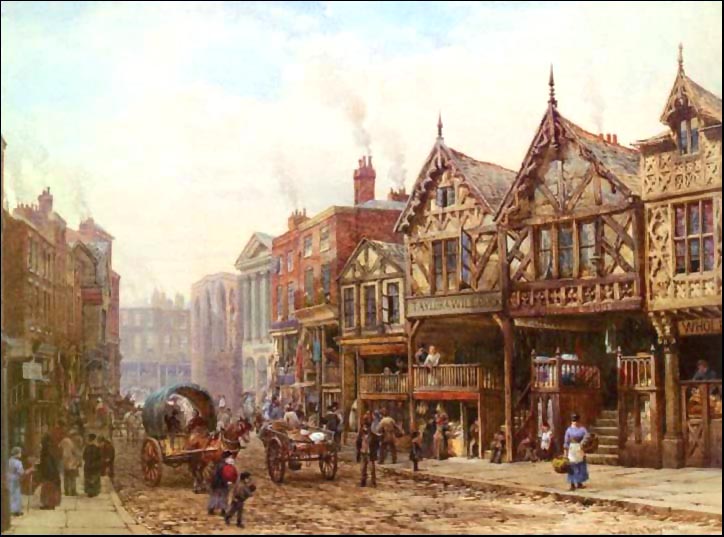Louise Rayner's Paintings of Chester

Northgate Street 2
Louise Rayner's Paintings of Chester

Northgate Street 2
Having passed from the Northgate and through the Market Square, we now arrive at the south end on Northgate Street. This end is medieval in origin; in Roman times the massive Praetorium (headquarters building) of the Roman fortress once stood on this spot. In fact, some of the huge column bases from the building still survive, and may be inspected, in the basement of one of the shops, a remarkable survivor. Northgate Street's junction with Eastgate Street at the Cross- the very centre of Chester- can be seen in the distance. This area still retains a certain period charm today but, surprisingly to some, virtually none of the buildings portrayed in this watercolour by Louise Rayner still exist. The exceptions- seen in both pictures- are the two at the far end of the street, the classical Commercial News Rooms and St. Peter's Church. The Commercial News Rooms was designed by the Chester architect Thomas Harrison and built in 1807-8, in a style very different to its surroundings. Its ground floor had originally been a row of shops but these were removed in 1923 and the space became a continuation of the public walkway beneath Shoemaker's Row. The news room above is decorated with Ionic half columns, above which are a pediment and tall windows, above which are decorative panels. When new, it was known as 'The Commercial Coffee Room and News Room' and was managed by a committee representing one hundred 'proprietors'- the major property owners and merchants of the day. Today, it continues to fulfill much the same function, bus is known as The City Club. The prolific Harrison was also responsible for, to name just a few, the Northgate, the rebuilding of the Castle and the Grosvenor Bridge. St. Peter's Church was traditionally founded in the early 10th century by Aethelflaed, "the Lady of the Mercians" and daughter of King Alfred the Great. She was also reputedly responsible for reoccupying the abandoned Roman fortress, re-fortifying and extending its defensive walls and endowing it as a burgh. Chester's role as a town, as opposed to merely a military fortress, starts from this time. Mentioned in the Domesday Book, the structure of the present church is of the 14th and 15th centuries with considerable later additions and alterations.
Many of Chester's visitors express surprise when they learn that this part of the Rows is largely a product of the 20th century. Several old inns once thrived along this stretch of Northgate Street. One had existed on the site of the Commercial News Rooms as far back as 1272 when Richard de Knaresburgh left his daughter a shop "near the inn which was Hugh Selimon's towards the church of St. Peter's". Nothing more is heard of it for 500 years until, in 1782, The Three Crowns' landlord was Thomas Lewis. In 1855, the author and guide Thomas Hughes described the inn as having an old and picturesque gable front and that its chief entrance was from Shoemaker's Row. He also remarked that it had enjoyed its finest days long before it was eventually demolished in 1808, when its sign and licence were transferred to new premises in Pepper Alley. The Woolpack Inn was located among the wooden buildings in the painting. On its site was later Sidoli's Restaurant, and, until recently, Weinholt's Bakery. |